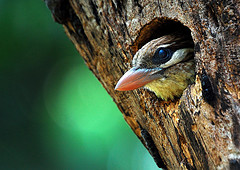February 25th, 2010 by Eugene Barsky | No Comments »

From UBC engineering folks…This work is the result of a collaborative effort between assistant professors Alireza Nojeh, nanotube expert, and Kenichi Takahata, micropatterning expert, of the department of electrical and computer engineering. The image was created by graduate student Masoud Dahmardeh with assistance from graduate students Parham Yaghoobi and Mohamed Sultan Mohamed Ali.
The area on which this image was created is smaller than a snowflake, yet it contains over 100 million carbon nanotubes. Nanotubes are not just tiny as their name suggests: Each is around 10 thousand times thinner than human hair and highly flexible. They also posses many other amazing properties: They are almost as light as air, better conductors of electricity and heat than copper, stronger than steel and tougher than diamond.
** Credit – http://www.apsc.ubc.ca/olympics.php#torch
Posted in Chemical and Biological Engineering, General Science, Main, Materials Engineering, Olympics, People | No Comments »
February 11th, 2010 by Kevin Lindstrom | No Comments »
BOULDER—Painting the roofs of buildings white has the potential to significantly cool cities and mitigate some impacts of global warming, a new study indicates. The new NCAR-led research suggests there may be merit to an idea advanced by U.S. Energy Secretary Steven Chu that white roofs can be an important tool to help society adjust to climate change.
Read the National Center for Atmospheric Research (NCAR) news release here. The full article published in Geophysical Research Letters can be read here.
Submitted by Kevin Lindstrom Liaison Librarian for Earth and Ocean Sciences
Posted in Atmospheric Science, Civil Engineering, Earth and Ocean Sciences, General Science, Geography, Mechanical Engineering, Physics | No Comments »
January 29th, 2010 by Kevin Lindstrom | No Comments »
The Street Level Forecast (SLF) is an interactive point forecast planning tool that brings customized forecasts to the user. SLF makes weather data accessible and user- friendly. Click on a specific location on an interactive map to receive personal forecasts such as wind and temperature that are provided on an easy-to-read graph.
The computer model that drives the SLF is run twice daily at a one kilometer resolution (a grid of points one kilometer apart across the region) and predicts conditions for the next 19 hours.
This SLF is an experimental prototype that Environment Canada will test during the Vancouver 2010 Olympic and Paralympic Winter Games period. This version will be live until March 31, 2010.
Submitted by Kevin Lindstrom Liaison Library for Earth and Ocean Sciences at the University of British Columbia
Posted in Atmospheric Science, Earth and Ocean Sciences, General Science, Geography, Main | No Comments »
January 15th, 2010 by Kevin Lindstrom | No Comments »
With the Winter 2010 Olympics less than 30 days away, the analytic chemists and their rivals are hard at work.
The journal Drug Testing and Analysis has a wide variety of articles looking at performance enhancing drugs and therapies.
Have a look at the article The hunt for gene dopers authored by Mansour, Mai M. H. and Azzazy, Hassan M. E.
Here’s the abstract of the article.
Gene doping, the abuse of gene therapy for illicit athletic enhancement, is perceived as a coming threat and is a prime concern to the anti-doping community. This doping technique represents a significant ethical challenge and there are concerns regarding its safety for athletes. This article presents the basics of gene doping, potential strategies for its detection and the role of promising new technologies in aiding detection efforts. These include the use of lab-on-a-chip techniques as well as nanoparticles to enhance the performance of current analytical methods and to develop new doping detection strategies. Copyright 2009 John Wiley & Sons, Ltd.
Medline and Web of Science and two excellent databases to monitor this spy vs spy battle between the IOC, the World Anti-Doping Agency and the performance enhancers.
Submitted by Kevin Lindstrom Liaison Librarian for Chemistry at the University of British Columbia
Posted in Chemistry, General Science, Main, News, Science - undegraduate classes | No Comments »
January 12th, 2010 by Eugene Barsky | No Comments »

The BBC has reported last week about scientists in Italy making artificial replacement bones out of wood – http://news.bbc.co.uk/2/hi/health/8438209.stm
A quick search in the Compendex database shows dozens and dozens of research reports of using wood as a possible implant material.
** photo by http://www.flickr.com/photos/challiyan/
Posted in Amusing stuff, Chemical and Biological Engineering, General Science, Main, Materials Engineering, Wood Sciences | No Comments »
December 18th, 2009 by Kevin Lindstrom | No Comments »
There are currently two very useful journal rankings SCImago and JCR. These rankings allow you to display amongst other things the h-index for a specific journal or a grouping of journals based on subject
“The SCImago Journal & Country Rank is a portal that includes the journals and country scientific indicators developed from the information contained in the Scopus® database (Elsevier B.V.).” Scopus contains more than 15,000 journals from over 4,000 international publishers as well as over 1000 open access journals. There are also over 500 conference proceedings in the database.
For more information, go to SCImago
“Journal Citation Reports® is a comprehensive and unique resource that allows you to evaluate and compare journals using citation data drawn from over 7,500 scholarly and technical journals from more than 3,300 publishers in over 60 countries.”
JCR Science Edition contains data from over 5,900 journals in science and technology.
JCR Social Sciences Edition contains data from over 1,700 journals in the social sciences.
For more information, go to JCR (Journal Citation Reports)
It is important to be aware of the size of the body of literature (the number of journals and conference proceedings) being indexed in Scopus and Web of Science. Journals listed in JCR are indexed in the Web of Science The larger the database, the greater the possibility that articles will be discovered, read, and hopefully cited. This is especially important for open access journals, some of which have not yet been indexed in the Web of Science.
Eigenfactor ranking is based on Web of Science data.
Submitted by Kevin Lindstrom Liaison Librarian for Science and Engineering
Posted in Astronomy, Atmospheric Science, Chemical and Biological Engineering, Chemistry, Civil Engineering, Earth and Ocean Sciences, General Science, Geography, Materials Engineering, Mathematics, Mechanical Engineering, Mining engineering, News, Physics, Science - undegraduate classes, Statistics, Uncategorized, Wood Sciences | No Comments »
December 15th, 2009 by Eugene Barsky | No Comments »

NYT today has an article on an issue of great importance to all science disciplines – data management. The article – “A Deluge of Data Shapes a New Era in Computing” overviews the new book published by Microsoft researchers – “The Fourth Paradigm: Data-Intensive Scientific Discovery.”
The book is available in full text from Microsoft here – http://research.microsoft.com/en-us/collaboration/fourthparadigm/4th_paradigm_book_complete_lr.pdf
This is a hot issue in science libraries too, as we are trying to understand how to deal with the vast amounts of digital data and whether libraries have a role to play to support, maintain and archive some of this data…
** photo by http://www.flickr.com/photos/nickwheeleroz/
Posted in Astronomy, Atmospheric Science, Chemical and Biological Engineering, Chemistry, Civil Engineering, Earth and Ocean Sciences, General Science, Geography, Main, Materials Engineering, Mathematics, Mechanical Engineering, Mining engineering, Physics, Science - undegraduate classes, Statistics, Wood Sciences | No Comments »
December 11th, 2009 by Kevin Lindstrom | No Comments »
Ron Simmer Patent and IP Expert has once agained issued his Patex Bizarre Patents Calendar.
This calendar documents the creative spirt of the human race reflected in patents.
Check out Ron’s excellent site of patent and intellectual property links at the Patex website.
Submitted by Kevin Lindstrom Science and Engineering Liaison Librarian
Posted in Amusing stuff, Astronomy, Atmospheric Science, Chemical and Biological Engineering, Chemistry, Civil Engineering, Earth and Ocean Sciences, General Science, Geography, Main, Materials Engineering, Mathematics, Mechanical Engineering, Mining engineering, News, People, Physics, Podcasts, Science - undegraduate classes, Statistics, Teaching, Uncategorized, Wood Sciences | No Comments »
November 27th, 2009 by Kevin Lindstrom | No Comments »
Author(s): Gerlich G (Gerlich, Gerhard)1, Tscheuschner RD (Tscheuschner, Ralf D.)
Source: INTERNATIONAL JOURNAL OF MODERN PHYSICS B Volume: 23 Issue: 3 Pages: 275-364 Published: JAN 30 2009
Abstract: The atmospheric greenhouse effect, an idea that many authors trace back to the traditional works of Fourier (1824), Tyndall (1861), and Arrhenius (1896), and which is still supported in global climatology, essentially describes a fictitious mechanism, in which a planetary atmosphere acts as a heat pump driven by an environment that is radiatively interacting with but radiatively equilibrated to the atmospheric system. According to the second law of thermodynamics, such a planetary machine can never exist. Nevertheless, in almost all texts of global climatology and in a widespread secondary literature, it is taken for granted that such a mechanism is real and stands on a firm scientific foundation. In this paper, the popular conjecture is analyzed and the underlying physical principles are clarified. By showing that (a) there are no common physical laws between the warming phenomenon in glass houses and the fictitious atmospheric greenhouse effects, (b) there are no calculations to determine an average surface temperature of a planet, (c) the frequently mentioned difference of 33 degrees is a meaningless number calculated wrongly, (d) the formulas of cavity radiation are used inappropriately, (e) the assumption of a radiative balance is unphysical, (f) thermal conductivity and friction must not be set to zero, the atmospheric greenhouse conjecture is falsified.
Click here to read the full article.
Submitted by Kevin Lindstrom Liaison Librarian for Earth and Ocean Sciences
Posted in Atmospheric Science, Earth and Ocean Sciences, General Science, Geography, Statistics, Uncategorized | No Comments »
November 13th, 2009 by Kevin Lindstrom | No Comments »
Sociologist Joseph Hermanowicz’ new book Lives in Science How Institutions Affect Academic Careers describes how the prestige of academic institutions often shapes the career of the individual.
“For all but a handful of the scientists he studies, the prestige of their institution pretty much determines their professional–and even their personal–destiny. Of the more than 4000 institutions of higher learning in the United States where a scientist can get a faculty post–ranging from world-renowned research universities to local community colleges–only a very limited number possess the resources, reputation, and connections needed for research careers at the highest levels of recognition.”
Click here for a full review of Hermanowicz’ book.
Submitted by Kevin Lindstrom Physical Sciences and Engineering Liaison Librarian
Posted in Astronomy, Atmospheric Science, Chemical and Biological Engineering, Chemistry, Civil Engineering, Earth and Ocean Sciences, General Science, Geography, Main, Materials Engineering, Mathematics, Mechanical Engineering, Mining engineering, News, People, Physics, Science - undegraduate classes, Wood Sciences | No Comments »



